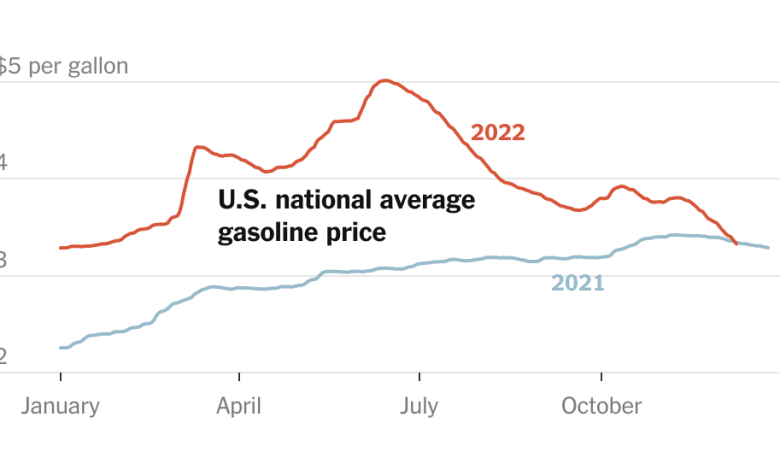U.S. Gas Prices Are Now Lower Than a Year Ago

After months in which gasoline prices in the United States have been one of the most visible symbols of inflation, they have a new distinction: Prices at the pump are now lower than they were a year ago.
The reversal of the price escalation that accompanied Russia’s invasion of Ukraine will ease pressure on American consumers dealing with the high cost of other essentials.
The drop in gasoline prices was led by a decline in worldwide energy demand, which drove oil prices lower. The national average price for regular gasoline stood at $3.33 a gallon on Thursday, according to AAA. A year ago, the average price at the pump was $3.34.
At their peak, gasoline prices were just over $5 a gallon in mid-June. The price of West Texas Intermediate crude oil, the U.S. benchmark that serves as the main driver of gas prices, this week fell to its lowest level of the year, at around $72 per barrel, after rising above $120 in March and June.
The drop is a political boon for the Biden administration, which has been drawing down the nation’s Strategic Petroleum Reserve since the spring in an effort to keep prices contained.
President Biden has also criticized energy companies for “profiteering” and threatened them with a new windfall profits tax unless they increased production. His administration has been highlighting the price declines on social media.
Falling gasoline prices may be welcome news for the Federal Reserve, too, as it tries to curb inflation by raising interest rates and slowing down the economy. Still, the economic implications could be complicated. As consumers spend less on gasoline, they have more cash for other purchases.
The State of the War
- Russia’s Long War: As his war in Ukraine drags on, President Vladimir V. Putin warned Russians that the battle would be protracted, but tried to allay the worst fears of an increasingly war-weary population.
- Striking Deep in Russia: In its most brazen attacks into Russian territory, Ukraine has been using drones to strike military bases inside Russia, showing an ability to take the war beyond its borders.
- Weaponizing Winter: Russian attacks on Ukrainian infrastructure have left millions without power, heat or water as the snow begins to fall. The Daily looks at what life is like in Ukraine as winter sets in.
- Russian Oil Price Cap: The E.U. agreed on a $60-a-barrel limit for Russian oil, the latest effort by Western allies to try to deprive Moscow of revenue to finance its war in Ukraine. Here’s how it will work.
“It’s good for households and it’s good for affordability,” said Beth Ann Bovino, the U.S. chief economist at the financial analysis firm S&P Global. “But at the same time the easing up of pricing pressure at the gas pump leaves more money to spend elsewhere, that might give a near-term boost to inflation, which the Fed would have to fight.”
The gasoline price trend has not been matched by diesel, a fuel essential to industry, agriculture and transporting goods. U.S. diesel prices have fallen in recent weeks, but are roughly 40 percent higher than a year ago, partly because of disruptions to Europe’s supplies.
While the decline in gasoline prices has been widely felt, some states still have prices well above the national average. In California, which has high gasoline taxes and rigorous emissions standards that increase the cost of refining, the average price of regular gasoline was $4.62 a gallon on Thursday,down from $6.44 in June. In several Southern and Midwestern states, however, prices are below $3 a gallon, mainly because they have minimal gasoline taxes, if any, and demand is lower in rural areas, according toDevin Gladden, an AAA spokesman.
Global oil prices account for more than half the cost of gasoline. The prices of both West Texas Intermediate and Brent crude, the global benchmark, have fallen more than 20percent since late August, as Covid-19 lockdowns in China reduced demand.
AAA expects gasoline prices to continue to decline through the end of the month, Mr. Gladden said, partly because winter-blend gasoline has fewer environmental restrictions, making it cheaper to produce.
But U.S. gasoline prices frequently decline in December before rising in January. And factors beyond the United States — including the Ukraine war and the decelerating world economy — make the outlook for the new year uncertain.
“We just have to continue watching oil prices because they remain volatile and as we saw in the spring, if oil prices spike to $100 per barrel, gas prices will follow suit,” he said. “A lot will depend on how the geopolitical tension continues to unfold throughout the winter.”
A further easing of China’s pandemic restrictions, for example, could prompt a rise in demand that would drive up oil prices. On Wednesday, the Chinese government loosened some of its rules after protests against its “zero Covid” policy.
“The stage is set for a spike in oil prices,” said Bryan Benoit,U.S. national managing partner of energy at the accounting firm Grant Thornton.
Clifford Krauss contributed reporting.
